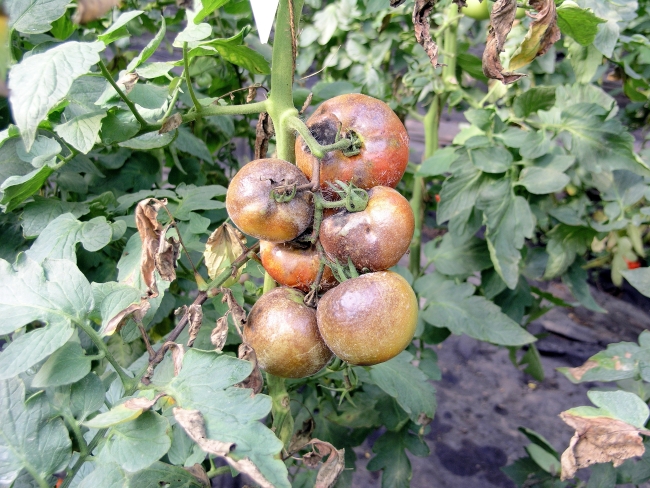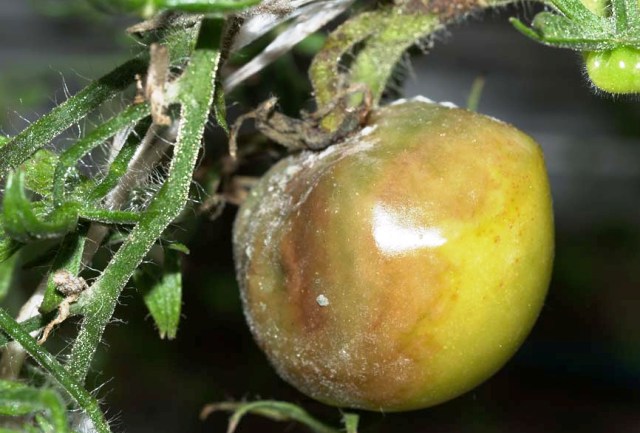Overview of tomato diseases: fungal, bacterial and viral
Fungal diseases
Fungal infestations appear on fruits, stems and leaves. The leaves get sick in such a way that brown spots form on them, and a pale yellow zone appears around them. If the weather is humid and warm, these spots grow quickly. A bloom appears on the bottom of the leaves. It is located over the entire surface of the infected area, or along the contour. Fruits can be sore at different stages of development. Green fruits, after they become ill, become covered with hard spots. The inner tissue of the fetus turns light brown. The size and shape of the spots can be different - from concentric to annular. If tomato disease develops successfully, the fruit turns brown completely.
Late blight
Late blight refers to fungal diseases. In addition to the usual manifestations, this tomato disease is characterized by the formation of spore-bearing signs, which are the result of repeated, or secondary infection. On diseased stems such negative factors as irregular spots appear.
The color of such spots is dark brown. They often join together and form necrotic interceptions. Fungal plaque does not appear on the surface of the plant. Prevention - soil sterilization, removal of diseased tomatoes. For chemical influence, sodium humate and pseudobacterin are suitable.
Alternaria
Dry spotting, also called Alternaria, produces concentric, rounded brown spots. The first manifestations of tomato disease can be seen on the lower leaves. Further, the disease spreads up the plant, and the manifestations become noticeable in the upper tiers. The affected areas are covered with spots with a diameter of 4-7 millimeters. After some time, their size increases, they become larger and can reach 10-15 millimeters in diameter. In protected ground, early manifestations are removed by Quadris, and for open ground, other substances are used - Ridomil and Metaxil.
Anthracnose
The roots of adult plants are exposed to anthracnose. They become covered with brown spots, the bark peels off, and microsclerotia gather under it. Ripe fruits are affected after ripening and can become infected when fully ripe or transported. The causative agent is a fungus that can spread in high humidity, which can be in protected ground.If the leaves and stems of the plant are covered with droplets, they can spread the disease. Treatment can be carried out with chemistry, Agatom-25, spraying. Breeders have bred varieties and hybrids of tomatoes that do not succumb to diseases, and are called F1 Life, Longf, Shelf. 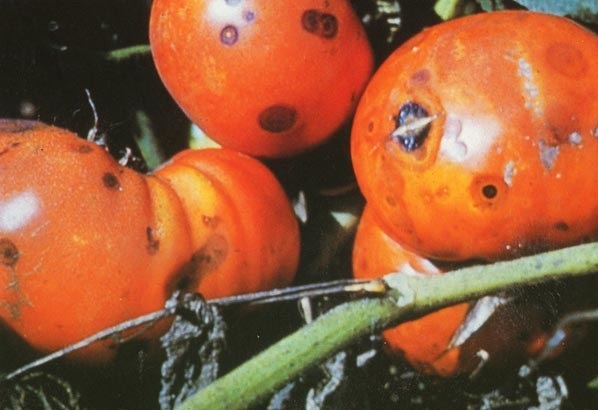
White spot
White spot (septoria) is very dangerous, as it can lead to the loss of half of the entire crop. Old leaves, those that are closer to the ground, are affected. After covering with persistent stains, they turn brown and dry out. The best temperature for the development of mottling can be 15 to 27 degrees with a humidity of 77%. Even in the remains of the plant, spores of the fungus remain. It is impossible to protect a plant from infection even with the help of chemicals. Some hybrid tomato varieties may be immune to spotting.
Gray rot
Gray mold is very dangerous. Infections spread to the entire stem, and tissues die off as a result of necrosis. Visually, rot resembles a grayish-white bloom, its appearance destroys the fruits, and the entire plant simply withers after infection. The generative organs are affected by high humidity. Also, the infection can be transmitted to other crops (which can be very likely in greenhouses) that can grow with or near tomatoes. For treatment, experts advise the use of timely agricultural measures, chemicals, such as growth regulators and chemical protection. The names of the drugs are Bayleton and Euparen.
White rot
White rot is also called sclerotinosis. A plant can become infected with a disease as a result of mechanical damage. The effect of the disease can increase as a result of a decrease in temperature and an increase in humidity - after cold rains. Poor ventilation in the greenhouse and the density of the planting can also cause the development of the disease. Signs - wilting, stem rot, cavity formation, the appearance of black sclerotia, white fluffy bloom, plant death. The causative agent of the disease can remain on the remains of the plant and in the soil. Disinfection of the soil, which must be done after the previous planting of plants, will help to get rid of the pathogen.
Powdery mildew
Powdery mildew infects tomatoes through the air, infection is carried out by the spread of conidia. The result of infection is a white bloom that appears on the top or bottom of the leaf. Sometimes appears on petioles and stems. The tissues then die off, and the leaves may fall off. 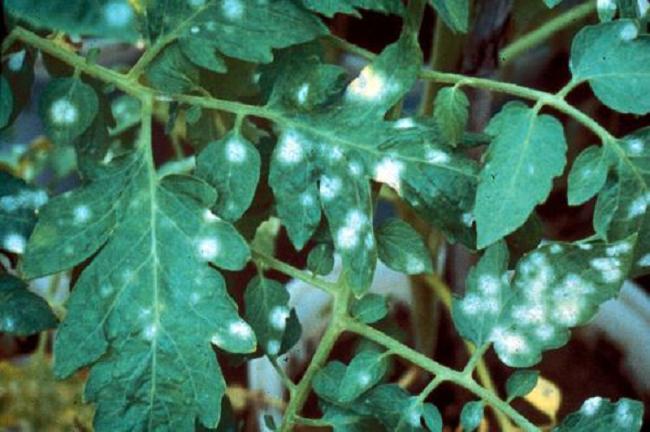 Low air humidity is quite sufficient for infection, but the first signs appear at a humidity of 80-90% and a temperature of 16-20 degrees. Diseased plants grow poorly, the number of fruits and their size decrease. The causative agent is a fungal infection. It is treated by spraying, sodium humate completely destroys the fungal infection. There is one stable hybrid, Milano F1.
Low air humidity is quite sufficient for infection, but the first signs appear at a humidity of 80-90% and a temperature of 16-20 degrees. Diseased plants grow poorly, the number of fruits and their size decrease. The causative agent is a fungal infection. It is treated by spraying, sodium humate completely destroys the fungal infection. There is one stable hybrid, Milano F1.
Verticillosis
Symptoms are most severe during the growing season and during the flowering period. First, the lower leaves wither, stains form on them, which lead to twisting and drying. Then the symptoms spread to the whole plant. The fungus passes through the vessels and clogs them. Under a microscope, you can see the mycelium, it is not pigmented, that is, colorless. The main thing for the fight is the cultivation of disease-resistant tomatoes, since there is no chemistry for treatment and prevention. Breeders have created a variety Zasolochny, resistant to verticillium.
Root rot
Root rot is very harmful and manifests itself in those areas of land that are over-watered.
It can appear on the plant immediately after planting if the soil is already infected with it. On the substrate and open ground, it occurs in areas with excess moisture. The development of the disease occurs throughout the life of the plant. Symptoms are blackening in the area of the root and neck, black leg. As a result, you can observe the wilting of the sprout. Sometimes rot can provoke the appearance of other diseases.Non-sterile soil and excessive watering can stimulate the development of this defect. Treatment and prevention - disinfection of the soil, dressing of seeds and seedlings, treatment with Rodomil Gold as a prophylaxis, treatment of the substrate.
Stem cancer
Stalk cancer does not manifest itself everywhere, and its appearance depends on the place where the tomato grows. In the open field, stem cancer is rare, but in greenhouses it can destroy the entire crop. 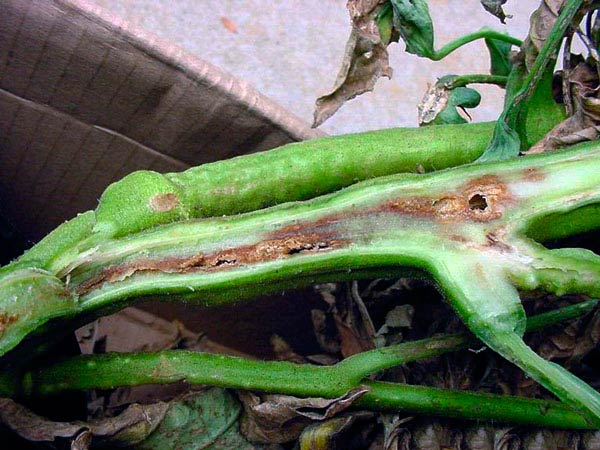 In stem cancer, the stems are most often affected, and sometimes the leaves. Gum begins to ooze from the stems, and the flowers become underdeveloped. Didimella virus develops in wet weather and low temperatures. Treatment - disinfection of the soil, the use of the drug Trichodermina. Sprouts and stems are sprayed with drugs to stimulate growth, Agat-25 or Immunocytophyte. Painful spots are treated with a paste of Rovral and chalk.
In stem cancer, the stems are most often affected, and sometimes the leaves. Gum begins to ooze from the stems, and the flowers become underdeveloped. Didimella virus develops in wet weather and low temperatures. Treatment - disinfection of the soil, the use of the drug Trichodermina. Sprouts and stems are sprayed with drugs to stimulate growth, Agat-25 or Immunocytophyte. Painful spots are treated with a paste of Rovral and chalk.
Fusarium wilting
Fusarium affects adult tomatoes and seedlings. Plants wither and die, may be underdeveloped. The first sign is the wilting of the top. Tissues become sluggish, and individual leaves wither and curl. The process starts at the top of the leaf. If the stem is cut off and examined, you will notice the browning in the vessels. Sometimes healthy plants can die in one day, namely at night. The infection spreads through the soil, which should be light and structureless. Fluctuations in temperature and humidity contribute to the development of fusarium. Watering before planting with pseudobacterin, growing resistant varieties - these are the methods of struggle.
Bacterial
Such diseases can pose a great threat to the crop. The vascular system is affected and the tomato withers. Spots appear on fruits and sprout. Problems begin on the sheet cover located at the bottom. Humidity and temperature contribute to the development of the disease. Sometimes even spraying and sprinkling does not bring the desired results.
Bacterial mottling
This type of growth disorder is difficult to develop in a greenhouse. It is very easy to identify visually. The first spots appear on the leaves, later they turn brown. The result of the disease is death.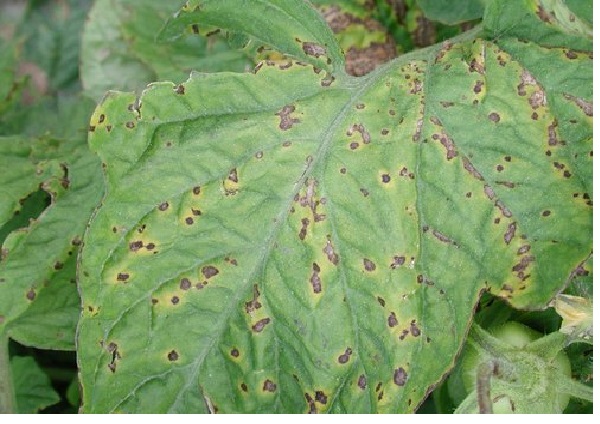 Speckling develops at high humidity and low air temperatures. Fungi are carriers of the disease and persist in seeds. The problem does not appear often; chemical fungicides rich in copper are used to treat it.
Speckling develops at high humidity and low air temperatures. Fungi are carriers of the disease and persist in seeds. The problem does not appear often; chemical fungicides rich in copper are used to treat it.
Bacterial cancer
Bacterial cancer can be very damaging - damage can be as high as thirty percent of the total crop. Everything differs in the whole lesion of plants, at the beginning of the infection the leaves wilt. Breeding grounds of bacteria become visible on the petioles in the form of brown growths. Withering starts from the bottom of the plant. A yellow core is also noticeable on the stem. The fruits deteriorate on the outside, but also inside, becoming covered with white spots.
Internal infection is much more severe than external infection, although the fruit is unusable in both cases. For prophylaxis, seeds are soaked in a TMTD solution. Fugnicides containing copper are needed for spraying plants during the growing season.
Bacterial wilting
Bacterial wilting of a tomato can be called a quarantine problem. This disease is considered the most dangerous. It is found throughout the territory of the CIS countries. The symptoms of tomato disease are very difficult to see with the naked eye. Tomatoes wither very quickly, after which they die, the infection can turn into a chronic stage. Only surviving plants lend themselves to treatment, others are destroyed. You can fight it by spraying Fitolavin with the addition of liquid glass.
Root cancer
Root cancer is rare, manifested by growths on the roots. They are small, inside them there is a concentration of bacteria. Tomato disease is determined using indicator plants. The source of infection is considered to be infected soil, and in order to avoid the spread of the disease, the roots are injured. Also, the virus dies when the soil is steamed.Soaking seedlings and their roots in Fitosporin is also effective in fighting cancer.
Wet fruit rot
Green and ripe fruits are affected by wet rot, this can happen during the growing season, during ripening and during transportation. First, spots appear, in appearance they are depressed and delimited from the healthy zone. Within 2-3 days, the pulp rots, turns into a liquid and colorless mass with an unpleasant odor. Then the skin of the tomato bursts and takes the form of a bag. 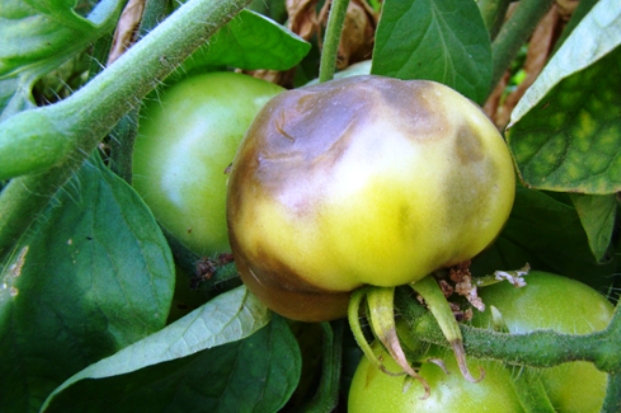 Unripe fruits are particularly susceptible to infection. If the storage temperature of the tomato is high, then 5-7 days are enough for it to rot. To prevent this from happening, it is necessary to eliminate insect pests and maintain the desired temperature during storage and transportation.
Unripe fruits are particularly susceptible to infection. If the storage temperature of the tomato is high, then 5-7 days are enough for it to rot. To prevent this from happening, it is necessary to eliminate insect pests and maintain the desired temperature during storage and transportation.
Black spot
The infection can damage a large part of the crop. The remaining and surviving fruits lose their appearance and taste. Tomato disease occurs in such a way that the plants become unstable and look unhealthy. Treatment with chemicals can help solve the problem, the frequency of treatment is 10-14 days.
Viral diseases
Tomato viral diseases can be very harmful. Everyone depends on the virus that has infected the sprout, the place of growth and the tomato variety itself. The fight against them comes by the destruction of insects that carry bacteria, the cultivation culture is maintained, and agromechanical influences on plants and the process of their growth are carried out.
Seedlessness
The harmfulness of aspermia has been proven, and depends on the type of virus and the conditions in which the tomato grows. Underdevelopment of generative shoots, strong bushiness - these are the signs of this disease. Any varieties are exposed to it, and a spider mite is considered a peddler, which must be fought against for this reason. 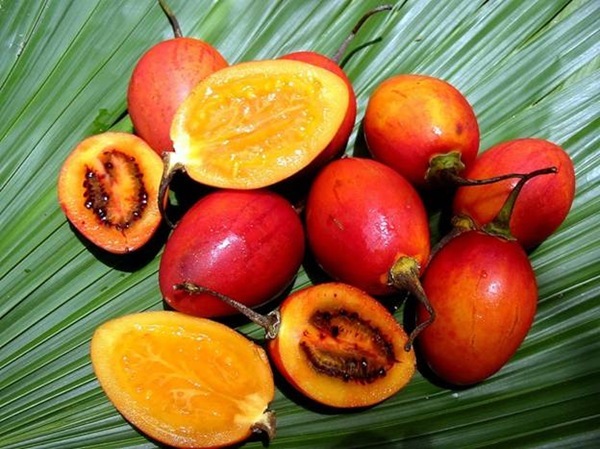 The leaves become small, change pigmentation, and the flowers acquire the ability to grow together. In order to prevent the development of the disease, it is necessary to destroy the insects that carry the infection, not to use reservators.
The leaves become small, change pigmentation, and the flowers acquire the ability to grow together. In order to prevent the development of the disease, it is necessary to destroy the insects that carry the infection, not to use reservators.
Bronze
The wilting of the leaves and their curling is called bronze. The virus gets stronger every year. Plants grown in greenhouses are very susceptible to problem wilting. In addition, a complete loss of the entire crop is possible. Brown patterns appear on the fruits, and later on the leaves, which leads to the death of the tops. The disease is not cured, however, at a temperature of 45 degrees, the activity of the virus is canceled.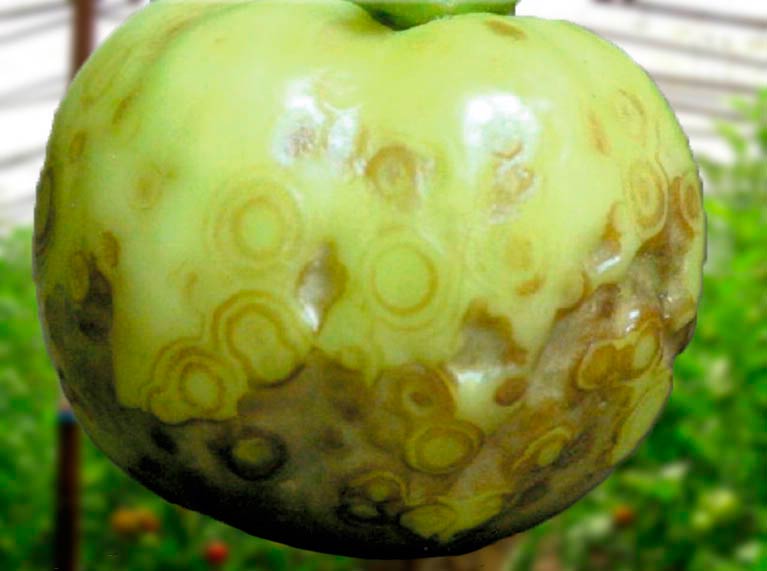
Yellow curl
Yellow curl can be a very unpleasant moment. It affects the appearance of ripe tomatoes. Their presentation is lost, the plants are colored unevenly, and the leaves curl, become small and deformed as a result of curling. The carrier of the virus is a whitefly, which must be dealt with, and treatment is carried out in any possible way. One of the hybrid varieties is disease resistant and is called F1 Senzafin.
Top toughness
It manifests itself in winter, dots appear on the leaves, which turn white. They darken and cause necrosis. Leaves stretch and curl. Infected plants grow poorly, deform, and their leaves become coarse. The infection is transmitted by aphids, there is no protection against the disease, and agromechanics are used to get rid of the problem. 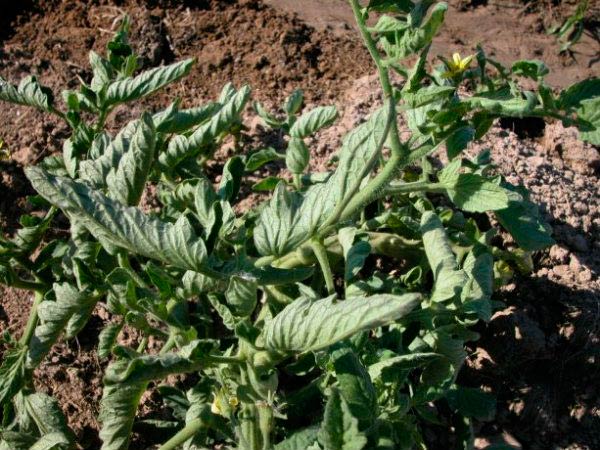
Mosaic
Mosaic can quickly damage many plants. It can also lead to a complete lack of harvest.
Leaves are the first to succumb to infection. They become stained, their original shape and color are lost. Together with other viruses, a new tomato disease can form. The virus is resistant to changes in temperature and humidity and is carried by insect pests. For prevention, normal conditions for plant growth are observed. Fight, or rather, prevent many diseases will help observance of the rules of crop rotation.It is necessary to monitor the place and sequence of planting, find varieties that are resistant to common diseases.
Video "Diseases of tomatoes"
By looking at the entry, you will find out what diseases of greenhouse tomatoes are and how to effectively deal with them.

